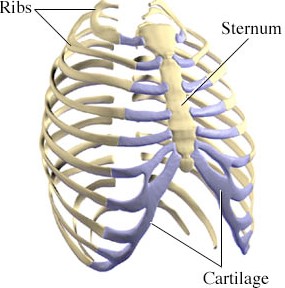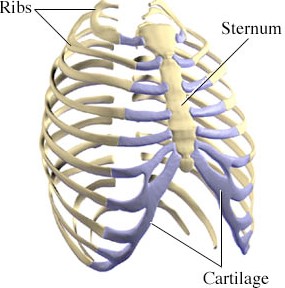Sternum, together with ribs form a shield that protects the chest’s front part. When you receive some severe blow in the sternum, it may result to development of bruises. The sternum becomes bruised. Sternum is located in middle section of chest and is at times also known as the breastbone. It is a flat bone that comprises of three parts including the manubrium, the body, and the xiphoid process.
Manubrium is where the first two ribs connect. The body of sternum is where the third to seventh rib attach themselves, and the xiphoid process or end of sternum is the smallest of these three parts, and it is where there is cartilaginous material that after some years develop to become rigid bony structure.
Since sternum is a strong bone, it protects vital organs of chest including lungs, heart, and blood vessels. Whenever there is a forceful impact hitting the breastbone or sternum, it can cause bruising. In most cases, car accidents are responsible for bruised sternum, although there may be other causes such as disease. Bruising of sternum should not be confused with sternum pain, which is also mainly caused by an injury in addition to health conditions and diseases, especially the cardiac disease.
Causes
Most often, the bruised sternum is caused by car accidents when a person drives without wearing seat belts. Forceful impacts are the culprits of this bruising. Certain sports such as contact boxing may also cause the problem. When you take contact sports without wearing a chest gear to protect this part of chest, you may be susceptible to an injury.
Whenever there is trauma in this area, it will result in bruising. Some activities can subject one to more risk of suffering a bruised sternum. When you are wearing a seatbelt during the time you are driving, you may be involved in an accident that creates force. The force may come from the seatbelt when it holds you in place to prevent you from being hurt. The force may also come from the steering wheel when you are not wearing seatbelts.
Sports injury is associated with bruised sternum. Some sports that are violent in nature increase the risk of suffering a bruising of the sternum. Bruising of sternum is common when you indulge in sports that do not require you to wear protective chest gear. It may be wresting, taekwondo, boxing, or other form of contact sports.
At times, hacking coughs may also cause this bruising. When you have a cough that is very strong requiring you to apply some force, it may put pressure on chest plate. The repeated force created by forceful coughing may cause the sternum to bruise if you are not able to control the cough.
Bruised Sternum – Symptoms
A bruised sternum may develop symptoms that tend to occur after an accident or the cause of the trauma, which results in the bruising. A person with bruised sternum will have bruises on chest and the areas around. The breastbone or sternum becomes tender to touch and there is pain in middle of chest especially over the sterna area. The pain mainly depends on severity of injury and the impact that is exerted over breastbone.
One may experience pain while laughing, coughing, holding hands high, or with movement of upper body such as bending backward, forward, and sideways. A person with bruised sternum may have problem with breathing, where they breathe shallowly due to the pain. The chest pain may last for weeks.
Patients who have bruised sternum often avoid having deep breaths because they tend to hurt and therefore the patients consider taking short breaths. It is therefore, important that you see a physician to examine you and rule out any possibility of having a fracture of sternum.
Treatment of bruised sternum
A bruised sternum may take about 1 to 4 weeks to heal but this time varies from one person to another, and depends on the severity of the trauma that causes the bruising. A patient will feel discomfort since there is pain even with slight movement of chest, for example, when you breathe, cough, and bend. A patient is unable to extend their hands upwards and one may find doing tasks such as lift weights and extending the hands over head to be difficult.
Patients can be administered with anti-inflammatory drugs to control the pain. This helps reduce the swelling and pain. Some home remedies may be applied to help in enhancing the healing such as ice fomentation and warm fomentation. Eating foods like pineapple that contain enzymes called bromelain may help fight inflammation.
A micro-current therapy may be performed to help in healing and repairing the tissue. This therapy helps in correcting the body electrical fields, which might have been disrupted at time of the injury. Painkillers may also be administered in addition to NSAIDs or non-steroidal anti-inflammatory drugs to manage pain and swelling.


